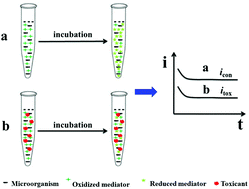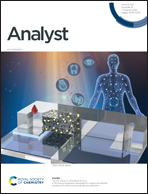An unexpected discovery of 1,4-benzoquinone as a lipophilic mediator for toxicity detection in water†
Abstract
Since most toxicological risk assessments are based on individual single-species tests, there is uncertainty in extrapolating these results to ecosystem assessments. Herein, we successfully developed a mediated microbial electrochemical biosensor with mixed microorganisms for toxicity detection by microelectrode array (MEA). In order to fully mobilize all the mixed microorganisms to participate in electron transfer to amplify the current signal, 1,4-benzoquinone (BQ) was used as the lipophilic mediator to mediate the intracellular metabolic activities. Hydrophilic K3[Fe(CN)6] was employed as an extracellular electron acceptor to transport electrons from hydroquinone (HQ) to the working electrode. Under the optimal conditions of 50 mM phosphate buffer solution (PBS), 0.4 mM BQ, 10 mM K3[Fe(CN)6] and OD600 = 0.5 bacteria concentration, the half-maximal inhibitory concentration (IC50) values measured with the composite-mediated respiration (CM-RES) of BQ–K3[Fe(CN)6] for Cu2+, Cd2+ and Zn2+ were 5.95, 7.12 and 8.86 mg L−1, respectively. IC50 values obtained with the single mediator K3[Fe(CN)6] were 2.34, 5.88 and 2.42 mg L−1 for the same samples. The results indicate that the biosensor with the single mediator K3[Fe(CN)6] had higher sensitivity to heavy metal ions than the biosensor with composite mediators. After verification, we found that the addition of BQ cannot amplify the current. The IC50 value of 0.89 mg L−1 for BQ was obtained using K3[Fe(CN)6] as the single mediator. This suggests that BQ is highly toxic, which explained why the sensitivity of the biosensor with the combined mediator BQ–K3[Fe(CN)6] was lower than that of the biosensor with the single mediator K3[Fe(CN)6]. At the same time, this also implies that toxicity itself cannot be ignored when it is used as an electronic mediator in a mediated microbial electrochemical biosensor.



 Please wait while we load your content...
Please wait while we load your content...